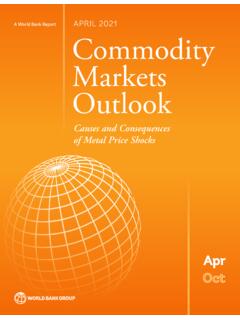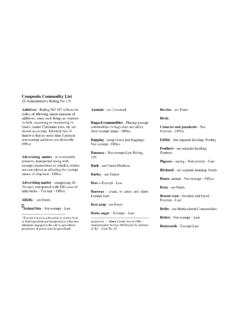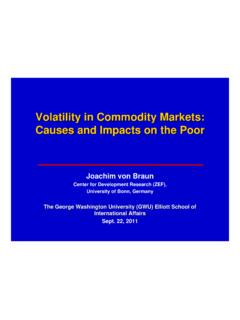Transcription of Commodity Price Risk Management - Deloitte
1 Commodity Price Ri sk ManagementA manual of hedging Commodity Price risk for Price Risk An do Corporates AddressCommodity Price Risk? is Commodity Price Risk Hedging? of Hedging Commodity Price Risk Futures and Options to HedgeCommodity Price of Hedging Commodity Price Hedge Accounting36 ContentsCommodity Price Risk Management | A manual of hedging Commodity Price risk for of Risk Management and Corporate TreasuryThe origins of risk Management pre-dates the 1700s with the use of probability theory to solve puzzles and its use was largely limited for theoretical purposes however, during World War II riskmanagement began to be studied andimplemented for various , risk Management in themarket place was always associatedwith the use of insurance to protectinstitutions and individuals from bearinglosses associated with , from the 1950s.
2 There were other forms of risk Management that emerged as alternatives to insurance especially when insurance coveragebecame costly and did not cover the riskexposure expected by the risk Management practicesbegan to emerge around 1955 and inthe 1970s, the use of derivatives asinstruments to manage or hedge against insurable or uninsurable risks began to be used and went on to be widely used from the 1980s. The wide-spread use of derivatives naturally lead to the formation of various international regulations of using derivatives with financial institutions developing internal risk Management models and capital calculation measures to protect themselves from unanticipated risks and reduce regulatory capital.
3 At the same time, in the corporate space as well, the governance of risk Management became essential with the emergence of the enterprise risk Management framework a framework that helps identify the various risks affecting the institution (see figure 1) across its business and operations and measures and plans to address, mitigate and monitor its impact on the institutionFigure 1: A typical risk universe of a corporate as part of the enterprise risk Management framework Board Performance /Tone at the Top Shareholder Expectations Third-Party Relationships Strategic Planning Annual Budgeting &Forecasting Alliances andPartnerships Competition Macro-Economic Factors Socio Political Events EmployeeCommunication Growth Innovation Marketing and Advertising Research and Development Customer/ SupportManagement Procurement and Inventory Transportation andLogistics Recruiting and Retention IT Security/ Access Natural Events Geopolitical Events Property.
4 Plant andEquipment Scalability Management InformationSystems Control Environment Environment / Health andSafety Intellectual Property /Trademarks Management Fraud Contract Ethics Liability Trade Regulations Customs Regulations Tax Compliance and AuditManagement Accounting, Reporting andDisclosure Interest Rate Changes Foreign ExchangeFluctuations Commodity PriceFluctuations Cash Visibility &Forecasting Capabilities Cash Movement Domestic & Cross-Border Funding Abilities Liquidity Concentration Working CapitalManagement Insurance Debt Management EquityStrategicOperationsComplianceFinan cial0504 Commodity Price Risk Management | A manual of hedging Commodity Price risk for corporatesCommodity Price Risk Management | A manual of hedging Commodity Price risk for corporatesAt many of the enterprise risk Management meetings.
5 Financial risk Management became an important discussion point at the Board of Directors and senior Management level due to the emergence of additional risks upon expanding business into new geographies, establishing trade relations with overseas buyers and suppliers and managing liquidity and cost of debt through effective funding and investment strategies. Accordingly since the late 1980s, several corporates began to establish a dedicated unit separate from the traditional financial & accounts department - which would manage these financial risks and supply chain costs for the institution this would be known as the treasury department for a Overview of Corporate Treasury Risk ManagementTreasury Management activities may be distinctly divided between the financial risk Management and financial supply chain Management functions respectively as highlighted in figure 2 below.
6 The objective of the financial risk Management function of a corporate treasury is to protect and preserve the value generated from the underlying business against external market forces such as: Changes in the interest rates in thedomestic or overseas geographieswhich may have an adverse impact onthe interest charges on the existingdomestic or foreign currency loanfacilities undertaken by the group orits entities Foreign currency movements that mayimpact an entity in the following ways: Gain/ loss on foreign exchangetransaction within its tradecycle mainly due to the fluctuation incurrency movements resulting fromthe timing difference on recognizingthe payable/ receivable for import/export to actually paying/ receivingthe foreign exchange amountFigure 2: An illustration of the typical roles of the treasury department of a corporateFigure 3.
7 Key Components of the Financial Risk Management LifecycleRisk AppetiteRisk Management StrategyRisk Management GovernanceRisk Operating ModelExposure identification/ recognitionExposure aggregation/ consolidationHedging transaction executionRisk mitigation/ performance assessmentFinancial supply chain managementFinancial risk managementDebt managementCash & liquidity managementInvestment managementForeign exchange risk managementInterest rate risk managementCommodity Price risk managementTreasury Management B udget-to-actual variance whichmay especially have a significantimpact on the profitability of an entitythat is either significantly dependenton purchasing from overseassuppliers or selling goods tooverseas buyers Foreign currency translation withrespect to consolidation of financialperformance limited to entitieshaving subsidiaries outside of itscountry of domicile Commodity Price fluctuations thatmay affect the Price of the commodityprocured, maintained as inventory (rawmaterial or finished goods)
8 Or sold tooverseas parties or even on domestictransactions where the referenceprice of the Commodity is affected byprice objective of the financial supply chain Management function of a corporate treasury is to ensure adequate liquidity to the underlying business functions either through cash or through the utilization of short term or long term debt facilities - and the optimization of the cost of financing by deploying surplus funds in those investment instruments that are permitted as per the risk appetite of the entity. Commodity Price Risk Management | A manual of hedging Commodity Price risk for corporatesCommodity Price Risk Management | A manual of hedging Commodity Price risk for corporates0607 Components of the Financial Risk Management LifecycleThe most important element with respect to risk Management to establish and assess the Risk Appetite of the entity.
9 As per the Institute of Risk Management , risk appetite can be defined as the the amount and type of risk that an organisation is willing to take in order to meet their strategic objectives . It establishes the tolerance that the Board of Directors is willing to accept with respect to the impact of risk on the entity s top-line ( revenue) and bottom-line ( EBITDA). Typically, the risk appetite of an entity is established as part of the enterprise risk Management framework based on which the financial risk Management strategy can be establishing the risk appetite, the Risk Management Strategy is the plan or strategic goals established for achieving the objectives within the boundaries of the risk appetite of the entity established by the Board of Directors.
10 In case of financial risk Management , the risk Management strategy encompasses the strategic plan to address the afore-mentioned financial risks affecting the entity based on the level of impact it has on the Company s financial performance. With the risk appetite and risk Management strategy established for financial risk Management , the life-cycle cannot be established without having an effective Risk Management Governance by way of oversight by the necessary senior Management and Board of Directors of the entity coupled with policies, guidelines and mandates which have been established for executing the risk Management strategy within the appetite established by the entity s Board of Directors.


















